radiator cap HONDA ACCORD COUPE 2001 CF / 6.G Owners Manual
[x] Cancel search | Manufacturer: HONDA, Model Year: 2001, Model line: ACCORD COUPE, Model: HONDA ACCORD COUPE 2001 CF / 6.GPages: 372, PDF Size: 6.1 MB
Page 53 of 372
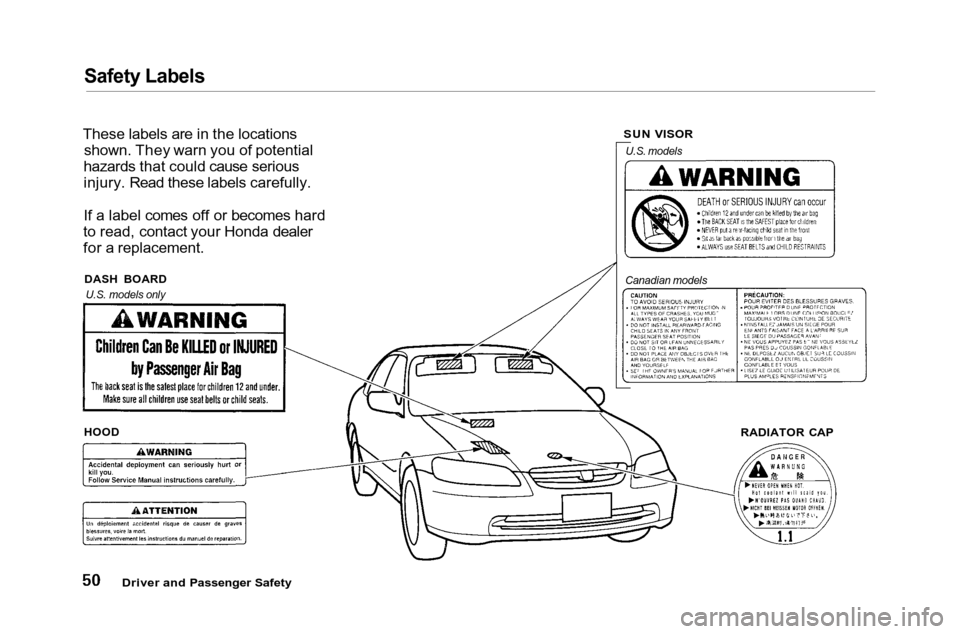
Safety Labels
These labels are in the locations shown. They warn you of potential
hazards that could cause serious
injury. Read these labels carefully.
If a label comes off or becomes hard
to read, contact your Honda dealer
for a replacement.
Driver and Passenger Safety
DASH BOARD
SUN VISOR
U.S. models
RADIATOR CAP
HOOD
Canadian models
U.S. models only
Page 235 of 372
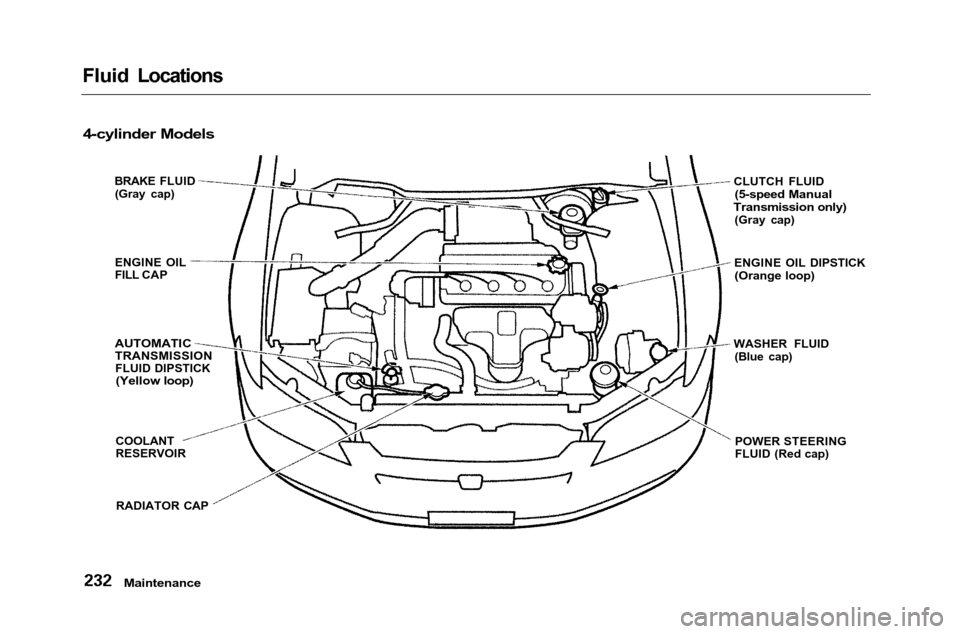
Fluid Locations
Maintenance
4-cylinder Models
BRAKE FLUID(Gray cap)
ENGINE OIL
FILL CAP
AUTOMATIC
TRANSMISSION
FLUID DIPSTICK
(Yellow loop)
COOLANT
RESERVOIR
CLUTCH FLUID
(5-speed Manual
Transmission only)
(Gray cap)
ENGINE OIL DIPSTICK
(Orange loop)
WASHER FLUID (Blue cap)
POWER STEERING
FLUID (Red cap)
RADIATOR CAP
Page 236 of 372
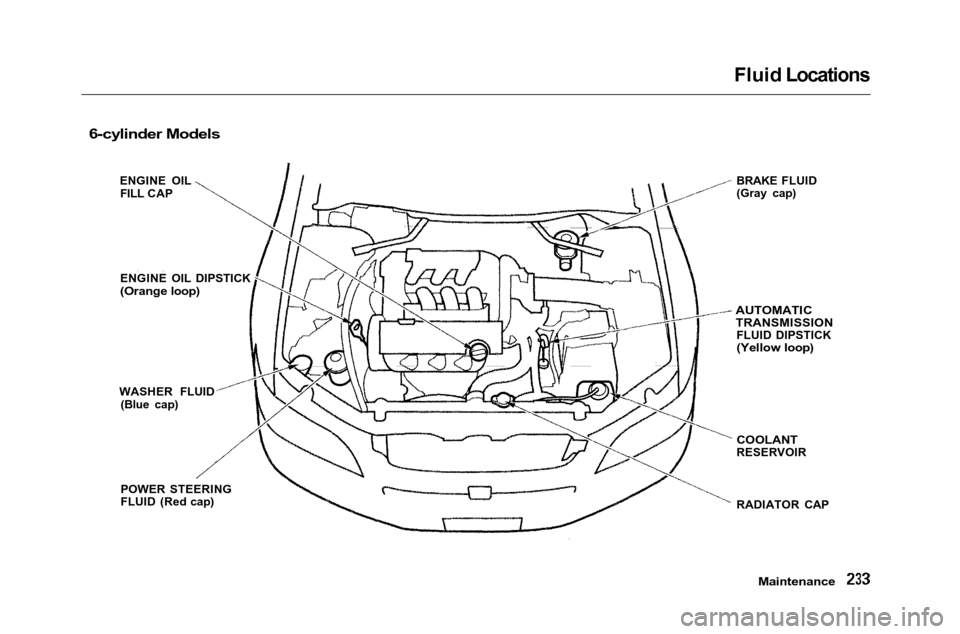
Fluid Locations
Maintenance
RADIATOR CAP
COOLANT
RESERVOIR
AUTOMATIC
TRANSMISSION
FLUID DIPSTICK
(Yellow loop)
6-cylinder Models
ENGINE OILFILL CAP
ENGINE OIL DIPSTICK
(Orange loop)
WASHER FLUID (Blue cap) BRAKE FLUID
(Gray cap)
POWER STEERING
FLUID (Red cap)
Page 243 of 372
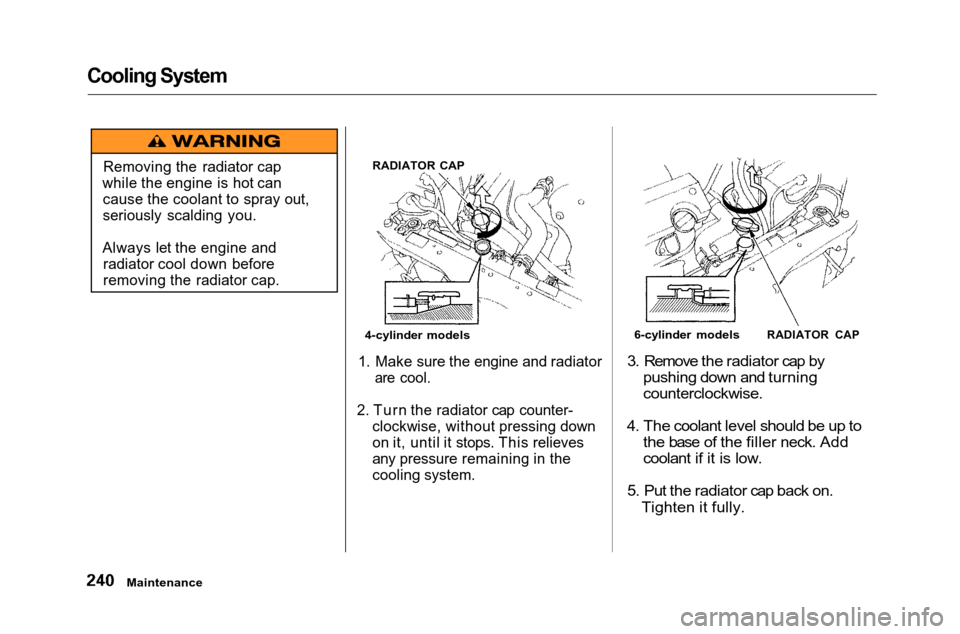
Cooling System
1. Make sure the engine and radiator
are cool.
2. Turn the radiator cap counter- clockwise, without pressing down
on it, until it stops. This relieves
any pressure remaining in the
cooling system.
3. Remove the radiator cap by
pushing down and turning
counterclockwise.
4. The coolant level should be up to the base of the filler neck. Add
coolant if it is low.
5. Put the radiator cap back on. Tighten it fully.
Maintenance
RADIATOR CAP
4-cylinder models 6-cylinder models
RADIATOR CAP
Removing the radiator cap
while the engine is hot can cause the coolant to spray out,
seriously scalding you.
Always let the engine and radiator cool down before
removing the radiator cap.
Page 245 of 372
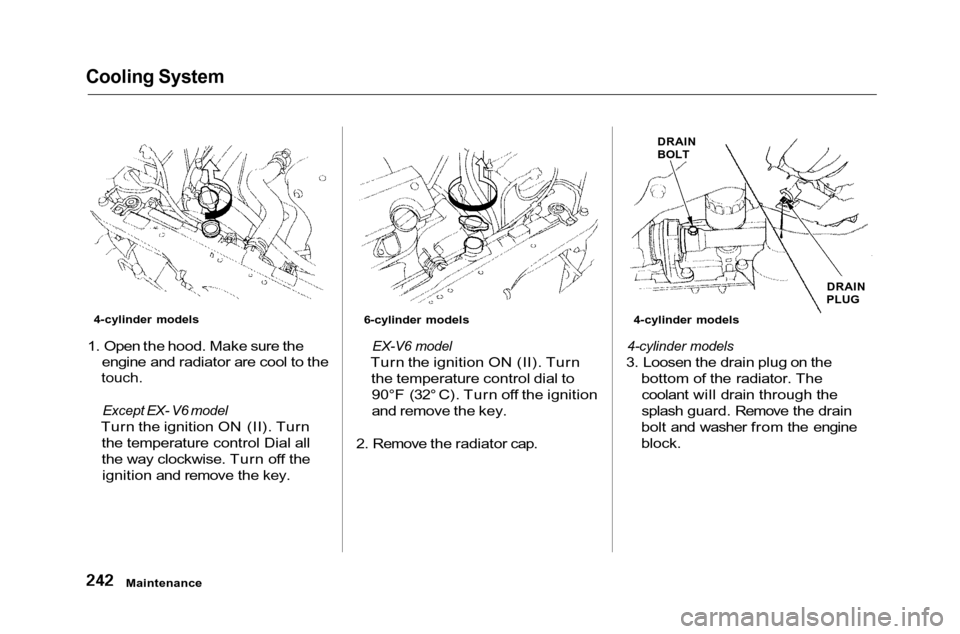
Cooling System
1. Open the hood. Make sure the engine and radiator are cool to the
touch.
Except EX- V6 model
Turn the ignition ON (II). Turn the temperature control Dial all
the way clockwise. Turn off theignition and remove the key.
EX-V6 model
Turn the ignition ON (II). Turn the temperature control dial to90°F (32° C). Turn off the ignition
and remove the key.
2. Remove the radiator cap.
4-cylinder models
3. Loosen the drain plug on the bottom of the radiator. Thecoolant will drain through the
splash guard. Remove the drain
bolt and washer from the engine
block.
Maintenance
DRAIN
BOLT
DRAIN
PLUG
6-cylinder models
4-cylinder models
4-cylinder models
Page 246 of 372
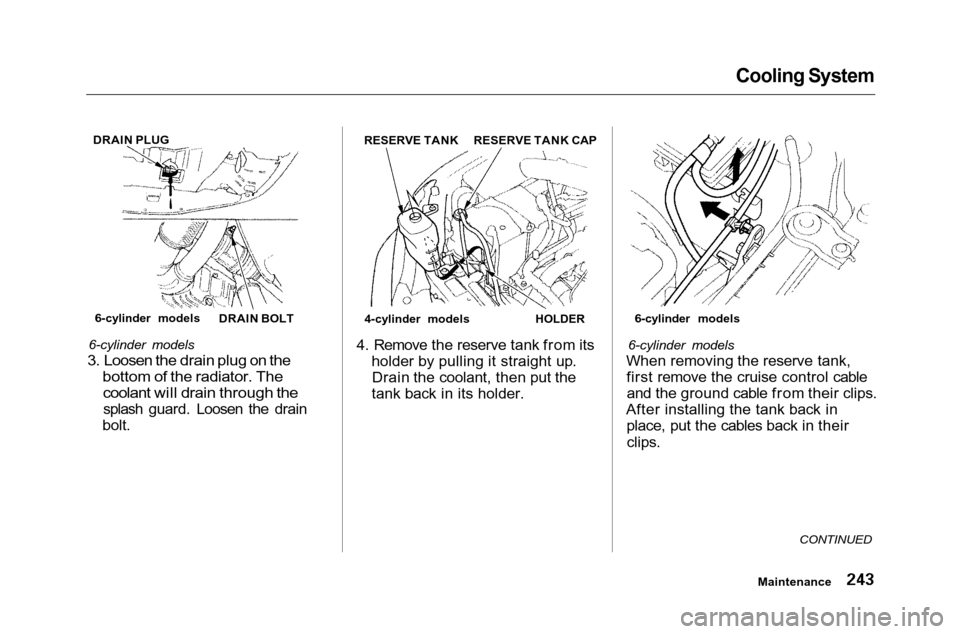
Cooling System
6-cylinder models
3. Loosen the drain plug on the
bottom of the radiator. The
coolant will drain through the
splash guard. Loosen the drain
bolt. 4. Remove the reserve tank from its
holder by pulling it straight up.Drain the coolant, then put the
tank back in its holder. 6-cylinder models
When removing the reserve tank, first remove the cruise control cableand the ground cable from their clips.
After installing the tank back in place, put the cables back in their
clips.
CONTINUED
Maintenance
DRAIN PLUG
RESERVE TANKRESERVE TANK CAP
HOLDER
DRAIN BOLT
4-cylinder models
6-cylinder models
6-cylinder models
Page 247 of 372
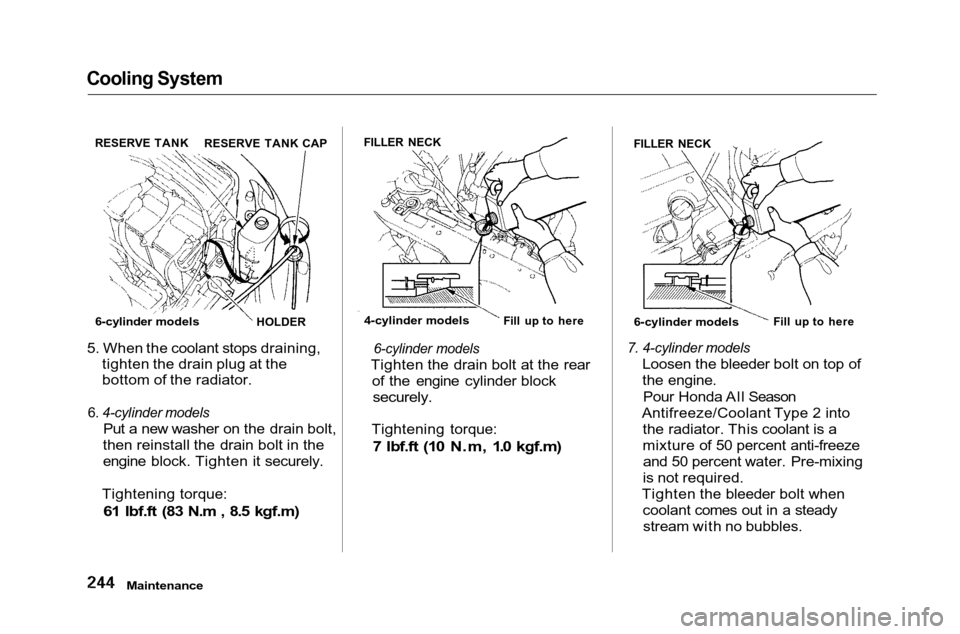
Cooling System
5. When the coolant stops draining, tighten the drain plug at the
bottom of the radiator.
6. 4-cylinder models
Put a new washer on the drain bolt,
then reinstall the drain bolt in the
engine block. Tighten it securely.
Tightening torque:
61 Ibf.ft (83 N.m , 8.5 kgf.m)
6-cylinder models
Tighten the drain bolt at the rear of the engine cylinder block
securely.
Tightening torque:
7 Ibf.ft (10 N.m, 1.0 kgf.m)
7. 4-cylinder models
Loosen the bleeder bolt on top of
the engine.
Pour Honda All Season
Antifreeze/Coolant Type 2 into the radiator. This coolant is a
mixture of 50 percent anti-freezeand 50 percent water. Pre-mixing
is not required.
Tighten the bleeder bolt when coolant comes out in a steadystream with no bubbles.
Maintenance
RESERVE TANK
RESERVE TANK CAP
HOLDER
6-cylinder models 4-cylinder models
Fill up to here
FILLER NECK
FILLER NECK
Fill up to here
6-cylinder models
Page 248 of 372
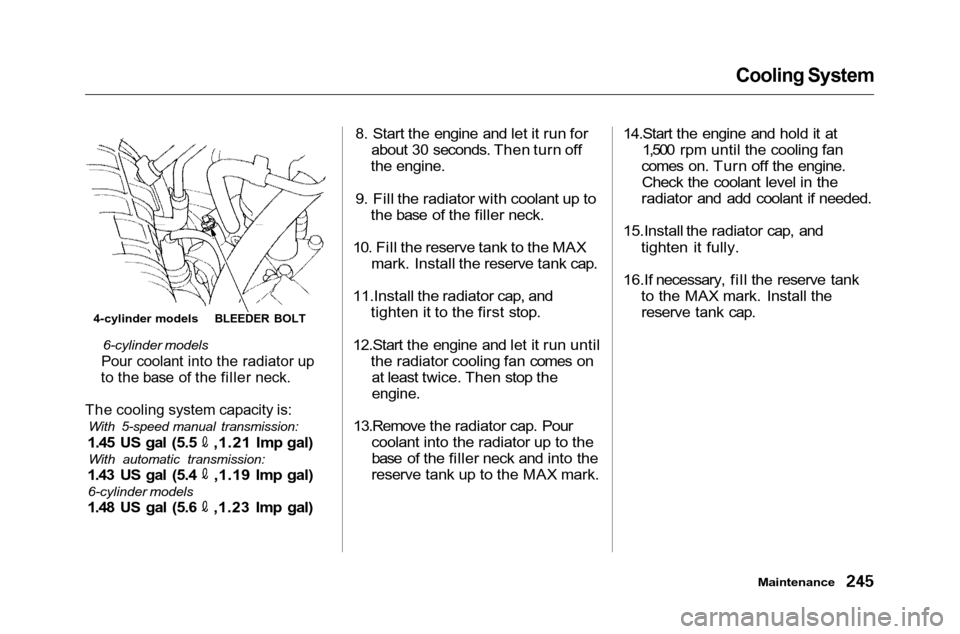
Cooling System
6-cylinder models
Pour coolant into the radiator up
to the base of the filler neck.
The cooling system capacity is:
With 5-speed manual transmission:
1.45 US gal (5.5 ,1.21 Imp gal)
With automatic transmission:
1.43 US gal (5.4 ,1.19 Imp gal)
6-cylinder models 1.48 US gal (5.6 ,1.23 Imp gal) 8. Start the engine and let it run for
about 30 seconds. Then turn off
the engine.
9. Fill the radiator with coolant up to the base of the filler neck.
10. Fill the reserve tank to the MAX mark. Install the reserve tank cap.
11.Install the radiator cap, and tighten it to the first stop.
12.Start the engine and let it run until the radiator cooling fan comes onat least twice. Then stop the
engine.
13.Remove the radiator cap. Pour coolant into the radiator up to the
base of the filler neck and into the
reserve tank up to the MAX mark. 14.Start the engine and hold it at
1,500 rpm until the cooling fan
comes on. Turn off the engine. Check the coolant level in the
radiator and add coolant if needed.
15.Install the radiator cap, and tighten it fully.
16.If necessary, fill the reserve tank to the MAX mark. Install thereserve tank cap.
Maintenance
4-cylinder models
BLEEDER BOLT
Page 268 of 372
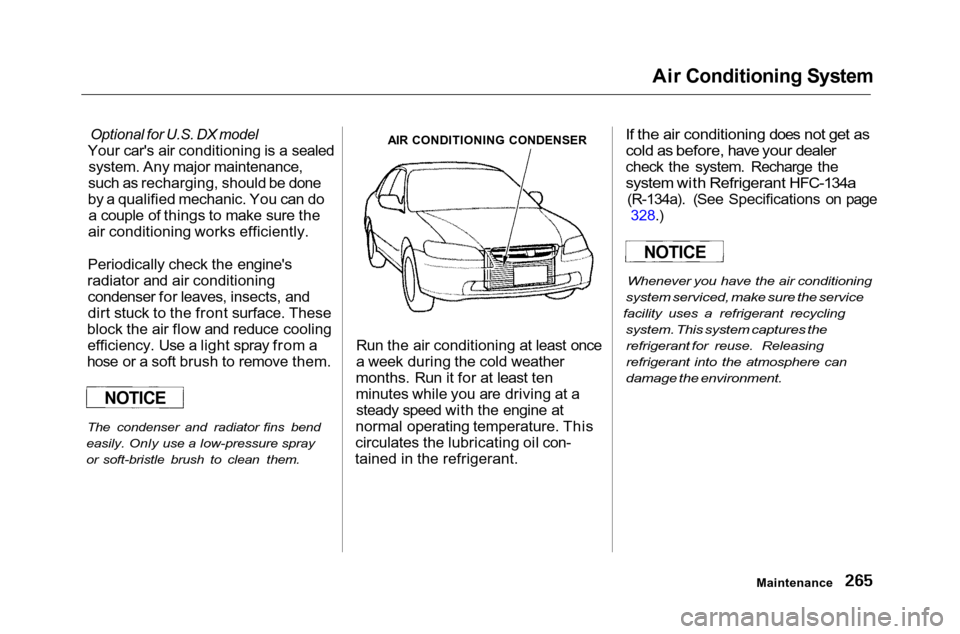
Air Conditioning System
Optional for U.S. DX model
Your car's air conditioning is a sealed system. Any major maintenance,
such as recharging, should be done
by a qualified mechanic. You can do a couple of things to make sure the
air conditioning works efficiently.
Periodically check the engine's
radiator and air conditioning condenser for leaves, insects, and
dirt stuck to the front surface. These
block the air flow and reduce cooling efficiency. Use a light spray from a
hose or a soft brush to remove them.
The condenser and radiator fins bend
easily. Only use a low-pressure spray
or soft-bristle brush to clean them.
AIR CONDITIONING CONDENSER
Run the air conditioning at least once
a week during the cold weather
months. Run it for at least ten
minutes while you are driving at a steady speed with the engine at
normal operating temperature. This
circulates the lubricating oil con-
tained in the refrigerant.
If the air conditioning does not get as
cold as before, have your dealer
check the system. Recharge the
system with Refrigerant HFC-134a
(R-134a). (See Specifications on page 328.)
Whenever you have the air conditioning
system serviced, make sure the service
facility uses a refrigerant recycling
system. This system captures the
refrigerant for reuse. Releasing
refrigerant into the atmosphere can
damage the environment.
Maintenance
NOTICE
NOTICE
Page 311 of 372

If Your Engine Overheats
4. If the temperature gauge stays at the red mark, turn off the engine.
5. Wait until you see no more signs of steam or spray, then open the
hood.
6. Look for any obvious coolant leaks, such as a split radiator hose.
Everything is still extremely hot,so use caution. If you find a leak, it
must be repaired before you
continue driving (see Emergency
Towing on page 320).
7. If you don't find an obvious leak, check the coolant level in the
radiator reserve tank (see page 184). If the level is below the
MIN mark, add coolant to halfway
between the MIN and MAX marks.
8. If there was no coolant in the reserve tank, you may also have to
add coolant to the radiator. Let the
engine cool down until the pointer reaches the middle of the tempera-
ture gauge, or lower, before check- ing the radiator.
9. Using gloves or a large heavy cloth, turn the radiator cap
counterclockwise, without pushing
down, to the first stop. This
releases any remaining pressure in
the cooling system. After the
pressure releases, push down on
the cap and turn it until it comes
off. 10. Start the engine and set the
temperature control dial tomaximum (climate control to
FULL AUTO at 90°F/32°C). Add
coolant to the radiator up to the
base of the filler neck. If you do
not have the proper coolant mixture available, you can add
plain water. Remember to have
the cooling system drained and refilled with the proper mixture as
soon as you can.
11. Put the radiator cap back on tightly. Run the engine and watch
the temperature gauge. If it goes
back to the red mark, the engine
needs repair. (See Emergency
Towing on page 320.)
12. If the temperature stays normal, check the coolant level in the
radiator reserve tank. If it has
gone down, add coolant to the MAX mark. Put the cap back on
tightly.
Taking Care of the Unexpected
Removing the radiator cap
while the engine is hot can
cause the coolant to spray out, seriously scalding you.
Always let the engine and radiator cool down before
removing the radiator cap.